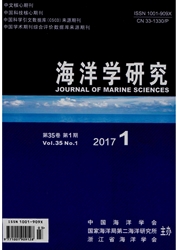

 中文摘要:
中文摘要:
采用组织学方法,获得患肾肿大症美国红鱼的心、脾、肾、肝、肠和鳃6种组织,利用组织切片以及超薄切片电镜技术对患病组织的病理变化进行了研究分析,探讨该病的致病机制。患病红鱼解剖后主要症状为:体表溃烂,部分病鱼鳍条上有肿块;病鱼肾脏显著肿大,体积甚至达到正常肾脏的10倍;肝脏、脾脏及胆囊等也有肿大现象;有些病鱼脏器上有白色结节。组织病理显示:美国红鱼肾肿大症的主要表现为肾脏有典型的肉芽肿,大量炎性细胞浸润,肾小管管壁破裂、坏死;肝脏中肝实质有充血现象,实质细胞呈空泡变性;脾脏充血,现大量病变的红细胞,有脂肪样变。超微病理显示:肾近曲小管上皮细胞凋亡现象严重,肾小管内刷状缘排列稀疏;肝细胞坏死严重,肝细胞界限模糊不清;脾脏组织脾窦扩张,有大量凋亡红细胞和淋巴细胞。实验结果表明:美国红鱼肾肿大症的组织细胞结构发生明显的病理变化,肾脏和肝脏等主要组织器官受到严重损伤病变,使鱼体不能进行正常的生命活动,最后导致死亡。
 英文摘要:
英文摘要:
The heart, spleen, kidney, liver, intestine and gill from Sciaenops ocellatus infected with kidney intumesce were pathologically analyzed by tissue slice and ultramicrocut electron microscopy techniques, so as to study the pathological changes of the tissues and the pathogenic mechanism of this disease. The anatomical symptoms of the diseased Sciaenops ocellatus are body surface ulceration, some lumps on the pterygiophore of some diseased fish, distinctly enlarged kidney (some 10 times as large as the normal one), enlarged liver, spleen and gallbladder, and white nodules on the viscera of some diseased fish. Histopathology shows that the main manifestations were typical granuloma, infiltration of large amount of inflammatory cells, rupture and necrosis of the tubular wall of the renal tubule, parenchyma hyperemia and vacuolar degeneration of the parenchymal cells in the liver, and abundant diseased erythrocyte appeared in the spleen with hyperemia and fatty degeneration. Ultrastructure pathology shows serious apoptosis of the epithelial cells of the kidney proximal tubule, sparse and ruptured brush border in the renal tubule, serious necrosis and blurred boundaries of the liver sell, and expansion of the splenic sinus of the spleen tissue, as well as abundant apoptosis cells of erythroeyte and lymphocytes. The results indicate that pathological changes widely occur in tissue cells of the kidney intumesce Sciaenops ocellatus and cause serious damage to the body organs, which makes the infected fish lose normal physiological metabolism and died at last.
 同期刊论文项目
同期刊论文项目
 同项目期刊论文
同项目期刊论文
 期刊信息
期刊信息
